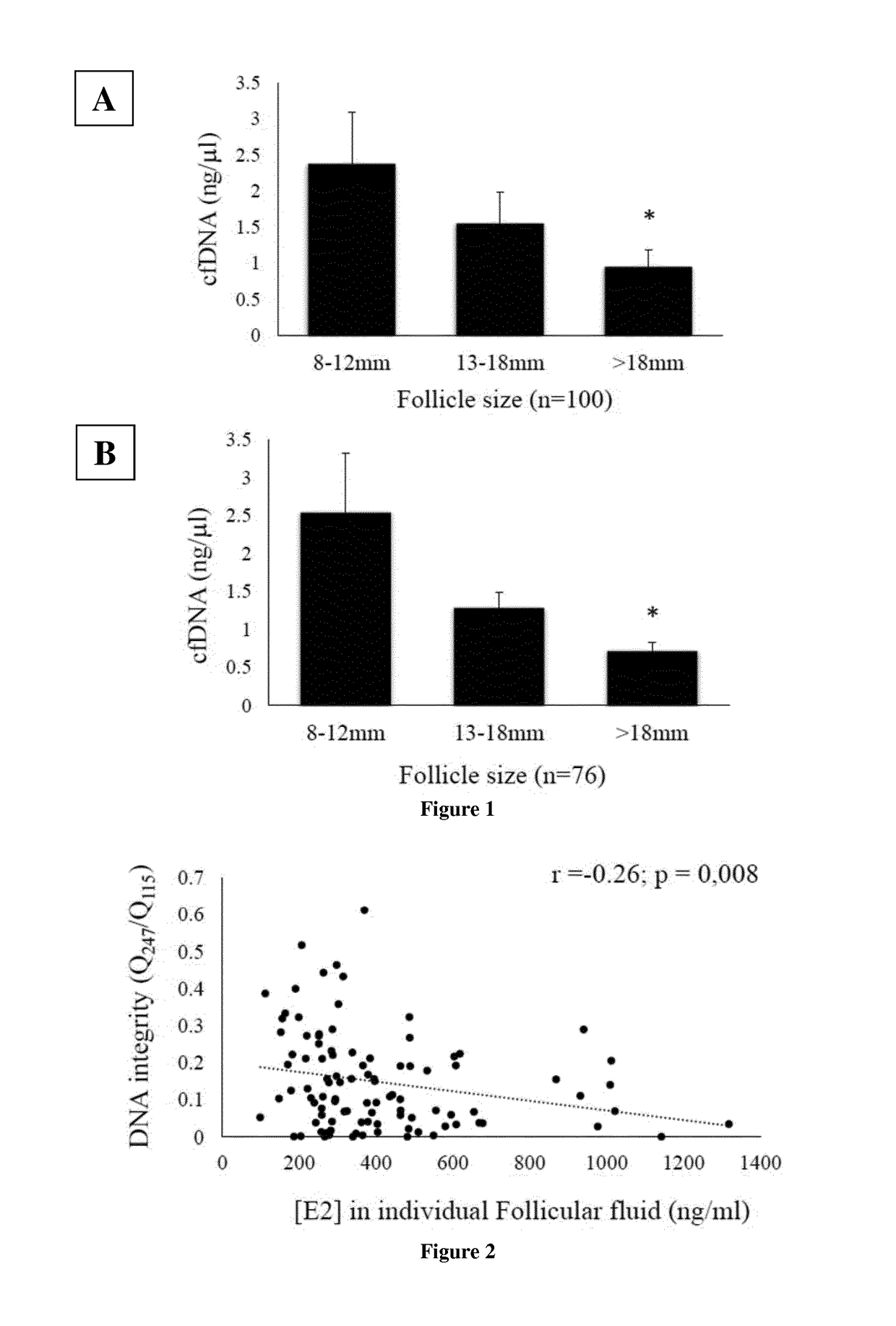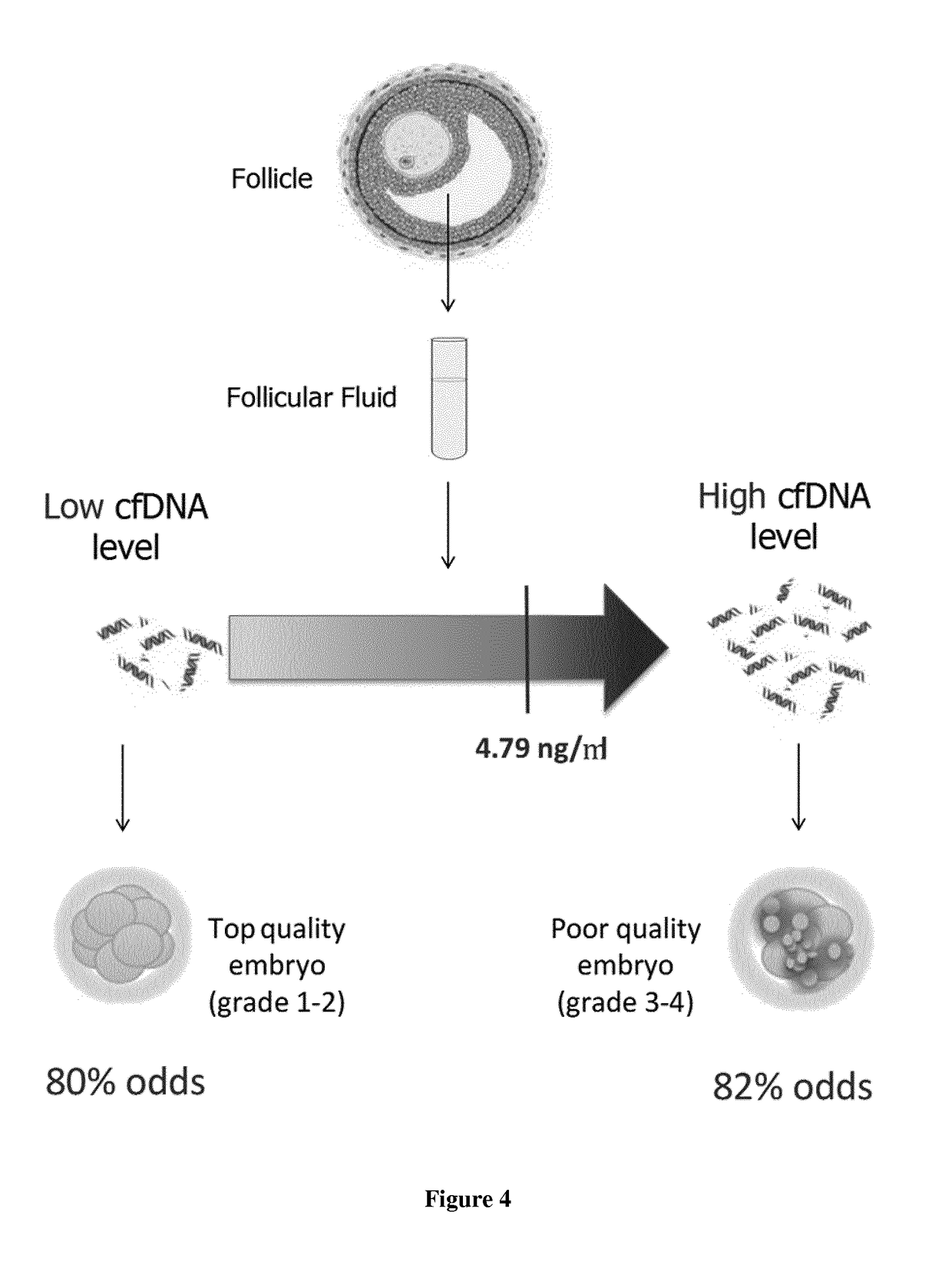Free nucleic acids and mirna as non-invasive method for determining embryo quality
a non-invasive method and technology of free nucleic acids, applied in the field of reproductive medicine, can solve problems such as limitations in subjective observation of embryo morphology to predict a successful pregnancy
- Summary
- Abstract
- Description
- Claims
- Application Information
AI Technical Summary
Benefits of technology
Problems solved by technology
Method used
Image
Examples
example 1
[0058]Material & Methods
[0059]Patients' Characteristics
[0060]This prospective study included 43 women undergoing controlled ovarian stimulation and IVF (n=26) or ICSI (n=17) procedures at the ART-PGD Department of the CHU of Montpellier, France. Written informed consent was obtained for the use of FF samples at the time of oocyte collection and the local Institutional Review Board approved the study. Based on the Rotterdam criteria, patients with polycystic ovary syndrome were excluded (Rotterdam, 2004). The patients' characteristics are reported in Table I. The women's age ranged from 24 to 40 years (mean±SD: 33.3±4.5 years) and their body mass index (BMI) was between 18 and 31 kg / m2 (mean±SD: 22.2±3.1 kg / m2). Infertility duration was 3.9±3.1 years (mean±SD) and 77% of couples were considered to have primary infertility.
[0061]Female infertility was the cause of the consultation in 58% of couples, while male factors, mixed or unexplained infertility were found in 32%, 5% and 5% of c...
example 2
[0094]Material & Methods
[0095]Patients
[0096]This prospective study recruited 100 women enrolled in conventional IVF (n=31) or ICSI (n=69) program at the ART-PGD Department of the University Hospital of Montpellier. The patients' characteristics are detailed in Table 1. The women's age was 34.3±4.5 years (mean±SD; range: 23 to 43 years) and the body index mass (BMI) was 23.3±4.2 kg / m2 (mean±SD; range: 17 and 39 kg / m2). The infertility length was 3.5±1.7 years (mean±SD). For 61% of the couples this was the first IVF or ICSI cycle and the remaining 39% of the couples had undergone at least one cycle (mean cycle number±SD: 2.1±1.3). In 11% of the couples, no specific cause of infertility was detected, while in the other couples, male (37%), female (36%) or mixed (16%) factors were identified. Based on the AMH level and AFC at day 3 of menstrual cycle, 94 of the 100 patients had a normal ovarian reserve and 6 had low functional ovarian reserve (LFOR). Basal FSH, LH and E2 levels were qua...
example 3
[0128]Materials and Methods
[0129]Patients
[0130]This prospective study included 131 women who underwent conventional IVF (n=32) or ICSI (n=99) at the ART-PGD Department of the University Hospital of Montpellier, France. Their mean age was 34.7±4.5 years (mean±SD; range: 19 to 43 years) and the body mass index (BMI) was 23.4±4.5 kg / m2 (mean±SD; range: 17 and 37.5 kg / m2) (Table 7). The infertility length was 3.6±1.5 years (mean±SD) and infertility was primary in 78 couples and secondary in the other 53. Male, female and mixed factors were detected in 31.3%, 37.4% and 25.2% of cases, respectively, while infertility was unexplained in 6.1% of couples. This was the first IVF or ICSI attempt for 38.9% of them, while 61.1% had already undergone at least one cycle (mean number of cycles±SD: 2.1±1.3). Among the 131 women, 91 had a normal ovarian reserve and 10 had LFOR, based on the serum AMH level and AFC, evaluated at day 3 of the menstrual cycle. The other 30 women had PCOS, according to t...
PUM
 Login to View More
Login to View More Abstract
Description
Claims
Application Information
 Login to View More
Login to View More - R&D
- Intellectual Property
- Life Sciences
- Materials
- Tech Scout
- Unparalleled Data Quality
- Higher Quality Content
- 60% Fewer Hallucinations
Browse by: Latest US Patents, China's latest patents, Technical Efficacy Thesaurus, Application Domain, Technology Topic, Popular Technical Reports.
© 2025 PatSnap. All rights reserved.Legal|Privacy policy|Modern Slavery Act Transparency Statement|Sitemap|About US| Contact US: help@patsnap.com



